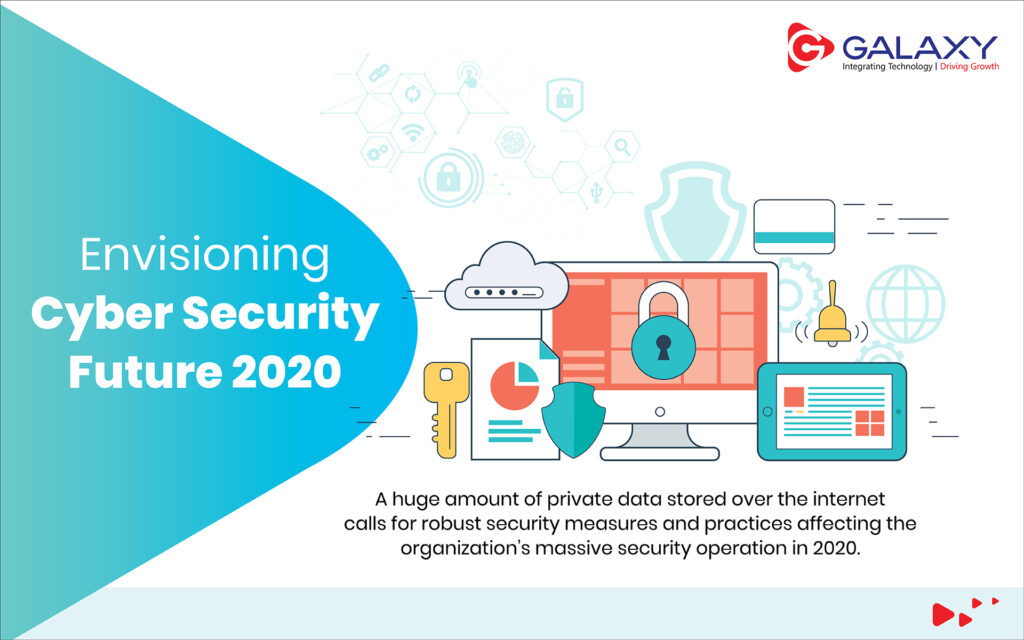
Envisioning Cyber Security Future - 2020
In today’s connected world, everyone relies on technology more than ever before. Cybercriminals have expanded their pace by entering into a computer every 40 seconds on average. And so cybersecurity has become the foremost priority of every organization as they are often the target of such attacks. Cybersecurity is the practice of defending internet-connected systems, networks, devices including hardware, software and data from attack, damage or unauthorized access. CyberSecurity is the new buzz in organizations and businesses whether large or small. Every business has different perspectives & priorities, and as cyber-attacks continue to get bigger every year it becomes important for every business to stay on top of the current trends in the cybersecurity news cycle. As breaches are not easily detected, protecting organizations from cyber threats will become difficult. Following are some of the cybersecurity trends that will be seen in 2020:
Cyber Security budget will persistently increase: CyberSecurity is the top priority of every organization professional’s mind. Companies’ annual investment in privacy and security has gone up and is estimated to increase further. Per employee, companies are spending an average of around $2,300 for cybersecurity. However, depending on the known and unknown threats, businesses progressively add resources into security solutions resulting in an increase in spending. Cyber budgets in 2019 have increased by 59%, which is around $124 billion. It is predicted to reach $128 billion by 2020. The biggest individual market with the largest spending is anticipated to be the US.
Attackers and Defenders will cash in on Artificial Intelligence: Artificial Intelligence(AI) and Machine Learning(ML) are taking the spotlight to identify and counter back to threats that crop up. AI-based solutions are implemented to work around the clock and have the potential to respond within milliseconds to attacks as compared to when identified manually. The brilliant side of the story is defenders can use AI to build strong security frameworks to automatically detect a threat and nullify threats before they harm the organization’s security. Simulated attacks can be performed on a network to block system weaknesses before malicious attacks. But AI isn’t perfect and has a flip side too. AI-based solutions can be used by cybercriminals to probe networks. Once an AI system is assaulted, cybercriminals can use AI to intensify their offensive activity. AI could also be used for phishing and launch other attacks via AI botnets designing realistic emails to dope individuals, hence making it difficult to identify major attacks. Over time, organizations will have to mop up the cybersecurity challenges that AI holds in the future.
5g Security Predictions: 5g connectivity comes with the use of a large number of IoT devices and BYOD (Bring your own devices). The network will move to distributed routing instead of centralized routing. This means it will become hard to screen all IoT devices, connecting to the 5g network and moving away from the central router makes them the prime targets for cyber attacks. 5g experts predict that more than 36 billion devices will be connected to the internet by the end of 2020. The ever-growing volume of personal data needs to protect against exploitation as 5g will collect small details about users mobiles, cars and other sensitive data that will give cybercriminals more opportunities for exploitation and attacks. The dramatic expansion of 5g creates a multidimensional cyberattack vulnerability.In the increase of emerging threats, redefined security solutions or framework is the need of an hour.
Expertise Adversity: The shortage of Cybersecurity professionals will continue to increase. The Cybersecurity training needs to be advanced as certifications alone won’t help. It has been a recurring issue for the last couple of years. The number of cybersecurity openings is flowing all over the place rapidly, but the supply can’t keep up the demands. This gap is expected to be widened by 2020. Cybersecurity Ventures recently estimated that the global shortage of cybersecurity will reach 3.5 million unfilled positions by 2021.
Cybersecurity’s future is in the clouds: Utilization of cloud has become inescapable, users store photos and memories, email accounts, business files, and other important personal data. With on-premise data spread across on public and private clouds, organizations do not have centralized control leaving several security gaps. To bridge these gaps organizations are constantly working on implementing hybrid environment solutions for cloud deployments for both public and private clouds.
Data Isolation and Guidelines will intensify: Organizations need to restructure their data privacy rules and regulations as the previous year it was predicted by the European Union(EU) will penalize violation of General Data Protection Regulations(GDPR). EU created GDPR for security protection of data for companies doing business with European customers. High-profile data breach attacks made consumers more and more demanding for better privacy rules. Government all around the world is so involved in the global cybersecurity crisis that they keep updating new data storage regulations. A huge amount of private data stored over the internet calls for robust security measures and practices affecting the organization’s massive security operation in 2020. The Indian government will reveal the official cybersecurity policy by January 2020.
The number of data breaches & attacks is increasing by the day. Cybercriminals are also getting advanced by using the double-sided sword of AI to break into organization cybersecurity. It becomes important to keep updated with the latest technologies. Merging the latest and existing technologies will help protect businesses of all sizes against upcoming threats.
So what do you think, is your organization Cyber Aware?
Attacks can come from any loose end, so Beware of the Trap.
FOR A FREE CONSULTATION, PLEASE CONTACT US.
